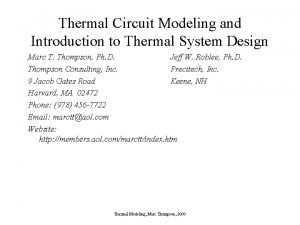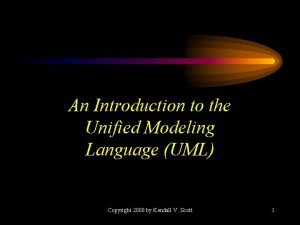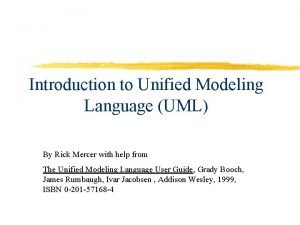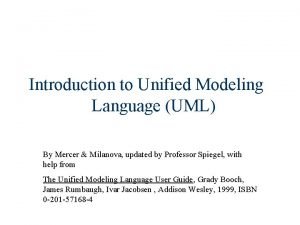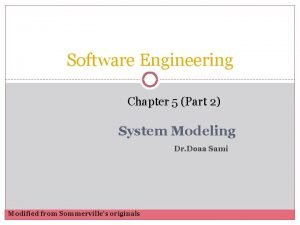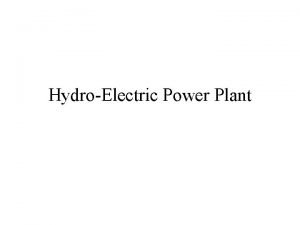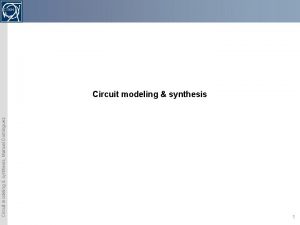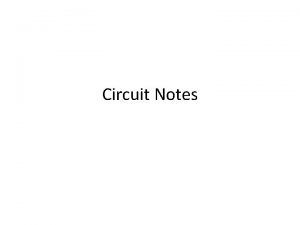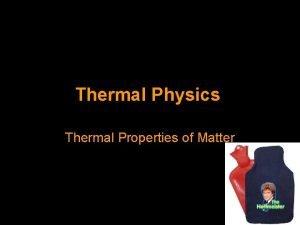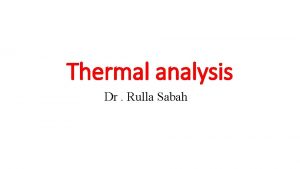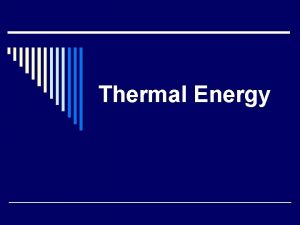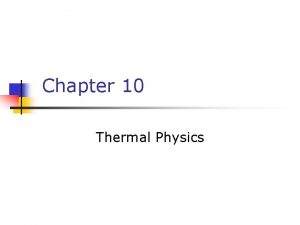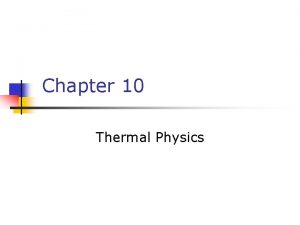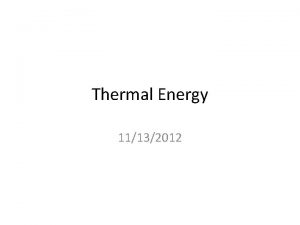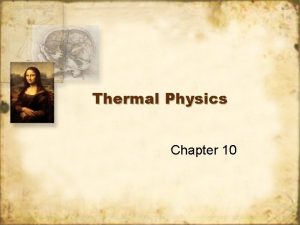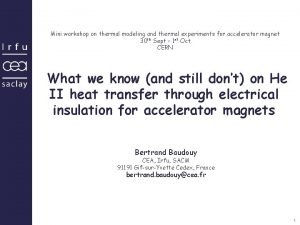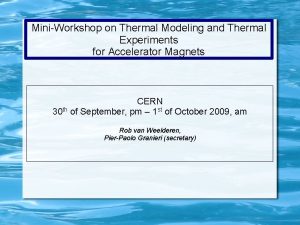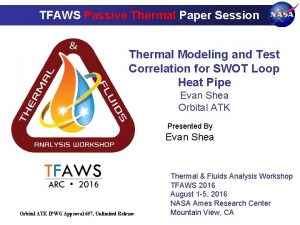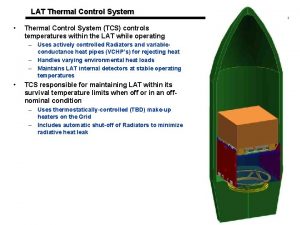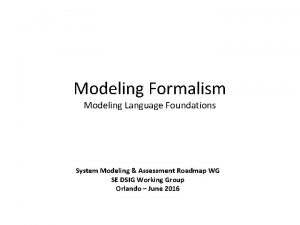Thermal Circuit Modeling and Introduction to Thermal System



























- Slides: 27

Thermal Circuit Modeling and Introduction to Thermal System Design Marc T. Thompson, Ph. D. Jeff W. Roblee, Ph. D. Thompson Consulting, Inc. Precitech, Inc. 9 Jacob Gates Road Keene, NH Harvard, MA 02472 Phone: (978) 456 -7722 Email: marctt@aol. com Website: http: //members. aol. com/marctt/index. htm Thermal Modeling, Marc Thompson, 2000

Summary • Basics of heat flow, as applied to device sizing and heat sinking • Use of thermal circuit analogies – Thermal resistance – Thermal capacitance • Examples – Picture window example – Magnetic brake 9/17/2020 Thermal Modeling, Marc Thompson, 2000 2

Intuitive Thinking about Thermal Modeling • Heat (Watts) flows from an area of higher temperature to an area of lower temperature • Heat flow is by 3 mechanisms – Conduction - transferring heat through a solid body – Convection - heat is carried away by a moving fluid • Free convection • Forced convection - uses fan or pump – Radiation • Power is radiated away by electromagnetic radiation • You can think of high- thermal conductivity such as copper and aluminum as an easy conduit for conductive power flow…. i. e. the power easily flows thru the material 9/17/2020 Thermal Modeling, Marc Thompson, 2000 3

Thermal Circuit Analogy • Use Ohm’s law analogy to model thermal circuits • Thermal resistance • k = thermal conductivity (W/(m. K)) • Thermal capacitance: analogy isn’t as straightforward • cp = heat capacity of material (Joules/(kg-K)) 9/17/2020 Thermal Modeling, Marc Thompson, 2000 4

Conduction • Heat is transferred through a solid from an area of higher temperature to lower temperature • To have good heat conduction, you need large area, short length and high thermal conductivity • Example: aluminum plate, l = 10 cm, A=1 cm 2, T 2 = 25 C (298 K), T 1 = 75 C (348 K), k = 230 W/(m-K) 9/17/2020 Thermal Modeling, Marc Thompson, 2000 5

Thermal Conductivity of Selected Materials References: 9/17/2020 1. B. V. Karlekar and R. M. Desmond, Engineering Heat Transfer, pp. 8, West Publishing, 1977 2. Burr Brown, Inc. , “Thermal and Electrical Properties of Selected Packaging Materials” Thermal Modeling, Marc Thompson, 2000 6

Heat Capacity of Selected Materials • Heat capacity is an indication of how well a material stores thermal energy Reference: B. V. Karlekar and R. M. Desmond, Engineering Heat Transfer, West Publishing, 1977 9/17/2020 Thermal Modeling, Marc Thompson, 2000 7

Heat Transfer Coefficient • Convection can be described by a heat transfer coefficient h and Newton’s Law of Cooling: • Heat transfer coefficient depends on properties of the fluid, flow rate of the fluid, and the shape and size of the surfaces involved, and is nonlinear Reference: B. V. Karlekar and R. M. Desmond, Engineering Heat Transfer, pp. 14, West Publishing, 1977 • Equivalent thermal resistance: 9/17/2020 Thermal Modeling, Marc Thompson, 2000 8

Free Convection • Heat is drawn away from a surface by a free gas or fluid • Buoyancy of fluid creates movement • For vertical fin: • Example: square aluminum plate, A=1 cm 2, Ta = 25 C (298 K), Ts = 75 C (348 K) 9/17/2020 Thermal Modeling, Marc Thompson, 2000 9

Forced Convection • In many cases, heat sinks can not dissipate sufficient power by natural convection and radiation • In forced convection, heat is carried away by a forced fluid (moving air from a fan, or pumped water, etc. ) • Forced air cooling can provide typically 3 -5 increase in heat transfer and 3 -5 reduction in heat sink volume – In extreme cases you can do 10 x better by using big fans, convoluted heat sink fin patterns, etc. 9/17/2020 Thermal Modeling, Marc Thompson, 2000 10

Thermal Performance Graphs for Heatsinks • Curve #1: natural convection (P vs. DTsa) • Curve #2: forced convection curve (Rsa vs. airflow) http: //www. electronics-cooling. com/Resources/EC_Articles/JUN 95/jun 95_01. htm 9/17/2020 Thermal Modeling, Marc Thompson, 2000 11

Radiation • Energy is lost to the universe through electromagnetic radiation • • = emissivity (0 for ideal reflector, 1 for ideal radiator “blackbody”); s = Stefan-Boltzmann constant = 5. 68 10 -8 W/(m 2 K 4) • Example: anodized aluminum plate, = 0. 8, A=1 cm 2, Ta = 25 C (298 K), Ts = 75 C (348 K) 9/17/2020 Thermal Modeling, Marc Thompson, 2000 12

Comments on Radiation • In multiple-fin heat sinks with modest temperature rise, radiation usually isn’t an important effect – Ignoring radiation results in a more conservative design • Effective heat transfer coefficient due to radiation for ideal blackbody ( = 1) at 300 K is hrad = 6. 1 W/(m 2 K), which is comparable to free convection heat transfer coefficient – However, radiation between fins is usually negligible (generally they are very close in temperature) 9/17/2020 Thermal Modeling, Marc Thompson, 2000 13

IC Mounted to Heat Sink 9/17/2020 Thermal Modeling, Marc Thompson, 2000 14

Cost for Various Heat Sink Systems • Note: heat pipe and liquid systems require eventual heat sink http: //www. electronics-cooling. com/Resources/EC_Articles/JUN 95/jun 95_01. htm 9/17/2020 Thermal Modeling, Marc Thompson, 2000 15

Comparision of Heat Sinks STAMPED EXTRUDED “CONVOLUTED” FAN http: //www. ednmag. com/reg/1995/101295/21 df 3. htm 9/17/2020 Thermal Modeling, Marc Thompson, 2000 16

2 N 3904 Static Thermal Model 9/17/2020 Thermal Modeling, Marc Thompson, 2000 17

Liquid Cooling • Advantages – Best performance per unit volume – Typical thermal resistance 0. 01 -0. 1 C/W • Disadvantages – – 9/17/2020 Need a pump Heat exchanger Possibility of leaks Cost Thermal Modeling, Marc Thompson, 2000 18

Heat Pipe • Heat pipe consists of a sealed container whose inner surfaces have a capillary wicking material • Boiling heat transfer moves heat from the input to the output end of the heat pipe • Heat pipes have an effective thermal conductivity much higher than that of copper 9/17/2020 Thermal Modeling, Marc Thompson, 2000 19

Thermoelectric (TE) Cooler • “Cooler” is a misnomer; a TE cooler is a heat pump • Peltier effect: uses current flow to pump heat from cold side to warm side • Pumping is typically 25% efficient; to pump 2 Watts of waste heat takes 8 Watts or more of electrical power • However, device cooled device can be at a lower temperature than ambient 9/17/2020 Thermal Modeling, Marc Thompson, 2000 20

Design Example --- Picture Window • Consider picture window with A = 1 m 2, 2. 5 mm thick • Ti = 70 F (25 C); Approximate To = 32 F (0 C) for 6 months (long winter !) • What is total cost for heat loss at $0. 10/k. W-hr? 9/17/2020 Thermal Modeling, Marc Thompson, 2000 21

Design Example --- Picture Window • Assumptions: – Window glass k = 0. 78 W/(m-K) – Inside and outside window, heat transfer dominated by free convection; h = 10 W/(m 2 K) • Riw = Row = 1/(h. A) = 0. 1 C/Watt • Rw = w/(k. A) =0. 0025/(0. 78)(1) = 0. 0032 C/Watt • Rtotal = 0. 2032 C/Watt • P = DT/Rtotal = 25 C/0. 2032 C/Watt = 123 Watts • E = 3 k. W-hr/day or 539 k. W-hr for winter • Cost = $53. 9 9/17/2020 Thermal Modeling, Marc Thompson, 2000 22

Design Example --- Picture Window with Double Pane • Assumptions: – Still air in airgap k = 0. 027 W/(m-K) – Ignore radiation • 1 cm airgap: Rairgap = g/(k. A) =0. 01/(0. 027)(1) = 0. 37 C/Watt • Rtotal = 0. 58 C/Watt • P = DT/Rtotal = 25 C/0. 58 C/Watt = 43 W • E = 1 k. W-hr/day or 188 k. W-hr for winter • Cost = $18. 80 – Cost will be lower if gap has vacuum 9/17/2020 Thermal Modeling, Marc Thompson, 2000 23

Design Example --- Temperature Rise in Magnetic Brake • Train mass M = 12, 300 kg • Initial speed = 16 meters/second • Brake aluminum fin length 10 meters • Stopping time: a few seconds • Cycle time: 1200 seconds • What is temperature rise in aluminum fin and in steel ? 9/17/2020 Thermal Modeling, Marc Thompson, 2000 24

Magnetic Brake --- Thermal Model • Model for 1 meter long section of brake • Guesstimated dominant time constant = 4, 500 seconds (0. 5 W x 9000 F) based on thermal model above 9/17/2020 Thermal Modeling, Marc Thompson, 2000 25

Magnetic Brake --- Temperature Profile 9/17/2020 Thermal Modeling, Marc Thompson, 2000 26

Other Important Thermal Design Issues • Contact resistance – How to estimate it – How to reduce it • Thermal pads, thermal grease, etc. • Geometry effects – Vertical vs. horizontal fins – Fin efficiency (how close together can you put heat sink fins ? ) 9/17/2020 Thermal Modeling, Marc Thompson, 2000 27
 Role modeling theory
Role modeling theory Relational vs dimensional data modeling
Relational vs dimensional data modeling Device modeling for analog and rf cmos circuit design
Device modeling for analog and rf cmos circuit design Introduction to modeling and simulation
Introduction to modeling and simulation Contoh proses stokastik dalam kehidupan sehari-hari
Contoh proses stokastik dalam kehidupan sehari-hari Complete and incomplete circuits with inference
Complete and incomplete circuits with inference Formula for venn diagram with 3 circles
Formula for venn diagram with 3 circles The circulatory system
The circulatory system Chapter 5 thermal energy answer key
Chapter 5 thermal energy answer key Thermal transfer vs direct thermal printing
Thermal transfer vs direct thermal printing Thermal circuit model
Thermal circuit model Introduction to the unified modeling language
Introduction to the unified modeling language Introduction to unified modeling language
Introduction to unified modeling language Introduction to unified modeling language
Introduction to unified modeling language Dfd ch5
Dfd ch5 System requirements checklist output example
System requirements checklist output example Series vs parallel current
Series vs parallel current Two types of circuits
Two types of circuits Phet circuit construction kit
Phet circuit construction kit Current in series
Current in series Short curcuit
Short curcuit Current in a parallel circuit
Current in a parallel circuit System modeling in software engineering
System modeling in software engineering Structural models in software engineering
Structural models in software engineering Mechanical system modeling examples
Mechanical system modeling examples Thermal power plant introduction
Thermal power plant introduction Dfd chapter 5
Dfd chapter 5 Modeling with quadratic functions
Modeling with quadratic functions










